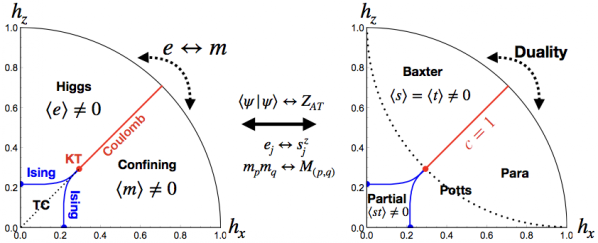Prof. Guang-Ming Zhang and his Ph. D student Guo-Yi Zhu have recently made significant progress in the field of quantum topological phase transitions. Their research work has been published on 30th April, 2019, as an article with the title Gapless Coulomb state emerging from a self-dual topological tensor-network state in the Physical Review Letter, a celebrated international journal. By revealing a novel quantum topological phase transition along the electric-magnetic self-dual line out of the Toric Code - a prototypical model of Z2topological order, they partially answer a long-standing important question, and provide new insight into a thorough solution of this puzzle.
In the three-dimensional space that we live, Nature has all the fundamental particles classified into either bosons or fermions, depending on whether exchanging two identical particles yields a π phase factor or not. However, in two dimension, particles are not limited to bosons or fermions. In fact, there could be more exotic which are dubbed as “anyons” by the Nobel Laureate F. Wilczek, in the sense that exchanging two particles could yield any phase beyond zero or π. Such anyons could emerge in the low-energy or long wave-length limit of fractional quantum Hall states or quantum spin liquids, which were earlier proposed in frustrated quantum magnets and high-temperature superconductors by P. W. Anderson. In the quantum spin liquids, the low-energy excited quasi-particles behave exactly as anyons and their mutual interaction is mediated by an emergent gauge field, whose description is beyond the conventional paradigm that characterizes phases of matter by means of spontaneous symmetry breaking established by Nobel Laureates L. Landau, V. Ginzburg, K. Wilson and many other physicists in the middle of last century. In dealing with the fractional quantum Hall states back in 1990s, Prof. Xiao-Gang Wen at MIT promoted the concept of quantum topological order that organizes the many-body constituent particles underlying such phases of matter. Nevertheless, most of the previous studies on the topological orders were based on the perturbative field theory or numerical calculations, until an exactly solvable model was introduced in 2003. A. Kitaev constructed a so-called Toric Code model consisting of bosonic spins on a square lattice, which is exactly solved and demonstrated all the properties of topological order successfully, even paving a new way to the topological quantum computation.
The Toric Code model can be viewed as the simplest discrete electromagnetic theory in two dimension. The low energy excited particles can be classified into four types: the electric charge (e), the magnetic π-flux (m), and the Majorana fermion (f). The electric charge and magnetic flux obeys bosonic statistics by themselves. However, according to the Aharonov-Bohm effect, braiding an electric charge around a magnetic flux generates a π phase, leading to a semionic mutual statistics. Distinct from the continuous electromagnetic theory that we’re most familiar with, this discrete electromagnetic theory describes the gauge fluctuation inside an s-wave superconductor, because the condensation of a pair of electric charges spontaneously breaks the continuous U(1) gauge symmetry and the charge conservation is reduced to the parity conservation law. Meanwhile, the otherwise continuous magnetic flux is quantized into multiples of π-flux. Above all, such a simplest electromagnetic theory in two-dimension exhibits rather elegant electric-magnetic duality, which is invariant under the exchange of electric charge with magnetic flux. Roughly speaking, the Toric Code model plays the role as the prototype model with topological order, just as the important role played by the Ising model in statistics mechanics. It serves as the cornerstone in any exploration into the topological ordered phases, and therefore the thorough understanding of its quantum phase transition is the key to establishing a universal framework of quantum topological phase transition beyond the Landau-Ginzburg-Wilson paradigm. A number of previous works elaborates on the Higgs transition with charge condensation accompanied by flux confinement, which is dual to the confining transition where flux is condensed accompanied by charge confinement instead. However, the Aharonov-Bohm effect seems to forbid the simultaneous condensation of electric charge and magnetic flux along the electric-magnetic self-dual line, leaving a long-standing puzzle until today.

The left figure shows the phase diagram of tuning the ground state wave-function of the Toric Code model, while the right figure is the phase diagram of the exactly solvable Ashkin-Teller model.
Inspired by the wave-function characterizing the fractional quantum Hall effect by Nobel Laureate R. B. Laughlin, Prof. Guang-Ming Zhang and his Ph.D. student Guo-Yi Zhu took a different route to tackle such a question. Instead of solving a perturbed model Hamiltonian, they tune an exact ground state wave-function from the topological order phase to the trivial phase and probed the possible topological phase transitions. Benefiting from the tensor-network representation, they successfully mapped the wave-function into a two-dimensional exactly solvable model in statistics mechanism, the so-called Ashkin-Teller model. They found that the partial ordered phase of the classical model corresponds to the topological phase of Toric Code, and by virtue of the exact solutions they accurately pinpoint the critical points of quantum topological phase transitions as well as the underlying microscopic mechanism. As it turns out, along the electric-magnetic self-dual line, the topological order phase undergoes a quantum Kosterlitz-Thouless phase transition into the gapless Coulomb state, during which process the screened interaction between electric charges evolves into the long-range Coulomb interaction. In a phenomenological sense, such a phase transition resembles the phase transition between a superconductor and normal metal. When the electric-magnetic self-duality is lost, the Coulomb state immediately falls into the charge condensation or charge confinement phase, described by the novel de-confined quantum critical theory. It should be noted that the Kosterlitz-Thouless phase transition is the first ever known topological phase transition that goes beyond the Landau-Ginzburg-Wilson paradigm in the history, which was proposed by D. Thouless and M. Kosterlitz back in 1973 and won them the Nobel prize in 2016.
This work is supported by the National Key R & D Program of China by the Ministry of Science and Technology.
Link:https://doi.org/10.1103/PhysRevLett.122.176401